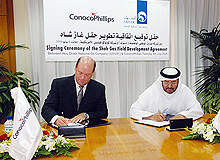
The Shah Sour Gas Field is located around 180km south-west of Abu Dhabi, UAE. It was jointly developed by Abu Dhabi National Oil Company (ADNOC) and Occidental Petroleum. The project came on stream in April 2016.
The project was to be originally developed jointly by ADNOC and ConocoPhillips. In July 2008, both parties agreed to develop the project, and in July 2009 agreed to share the project cost. A new company was expected to be set up to the project, where ADNOC and ConocoPhillips would have 60% and 40% stakes respectively.
In April 2010, however, ConocoPhillips declared its decision to end its partnership in the Shah project. ConocoPhillips said that the decision was part of the company’s shift in focus from downstream and midstream activities towards upstream exploration and production activities. However, industry analysts feel that the estimated low returns from the project may have been responsible for the decision. The move was considered as the company attempts to improve its financial position after it adopted a failed debt-financed acquisition strategy in 2008.
In 2011, ADNOC partnered with Occidental Petroleum for the development of the project.
Shah reserves
Abu Dhabi has more than 200 trillion cubic feet of gas reserves and a substantial portion of it remains unexploited. Sour natural gas and condensate reservoirs were developed as part of the Shah project.
The project is targeting production of one billion cubic feet a day of sour or sulphur-rich gas and to convert 500 million cubic feet of fuel and 10,000t of sulphur for sale.
Bidding and studies
The Shah sour gas project was initially planned to be developed along with the Bad field. The bidding for developing the Shah Field started in April 2007.
However, the bidding companies were reluctant to undertake the development of Bad field along with the Shah Field because of the associated technical and environmental risks.
The development of Shah Gas Field was therefore decided to be made separately rather than with the Bad field. In August 2007, bids from four companies were received for the Shah Field development.
In 2008, a 3D seismic survey was conducted over the field. Technical studies were carried out by Shell and ExxonMobil, while the conceptual study was carried by Fluor Corporation.
The FEED study for the project was completed by March 2009 and individual optimisation studies for the field’s sour gas reserves were carried out by Occidental and BP.
Shah development packages
The Shah sour gas field was developed in ten main packages, focusing primarily on the development of wells and gathering systems, and the construction of a gas sweetening and treatment facility in Shah. The notice for open tenders for the first four packages was issued in May 2009.
The first package involved development of the gas gathering system, which covers the development of wells, pipelines and gathering lines. Package two constituted a process plant includes four acid gas removal units, each with a 25% capacity, two natural gas liquid (NGL) recovery trains with a capacity of 50% each, and two condensate hydrotreater trains with 50% capacity each.
Package three covered four sulphur recovery units with tail gas treatment units, each with a capacity of 25%. Offsites and utilities were managed under package four.
Different pipelines, namely gas, condensate and natural gas liquids, were developed under package five. Package six includes a 275km liquid sulphur pipeline to carry sulphur from the Shah Field to Ruwais via Habshan.
Package seven involved the development of a terminal with a liquid sulphur storage capacity of 21,000tpd and 11,000tpd granulation units. Storage facilities for solid sulphur and marine facilities for loading and export will be developed under package eight.
Package nine included early work, including construction of plant roads, security fences and support facilities. The non-process buildings such as workshops, warehouses and vehicle maintenance were constructed under package ten.
Sulphur pipeline details
Tendering for the sulphur pipeline package started in June 2009. ADNOC preferred Saipem to construct 250km of pipeline system for transporting sulphur from the field.
The company may opt for rail to transport the sulphur because there is risk involved when dealing with sulphur by-products.
Shah contracts
The construction contract for package nine of the project was awarded to Al Jaber Group in March 2010. The scope of work includes building infrastructure including roads and gas treatment plants. The contract is valued at $300m.
Saipem was contracted to perform engineering, procurement, and construction (EPC) of the gas process plant and sulphur recovery unit, as well as the 250km-long pipelines.
Fluor provided conceptual development, front-end design and project management services for the EPC packages of the project.



